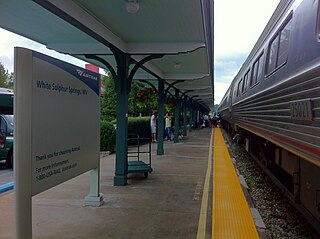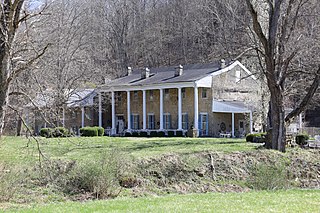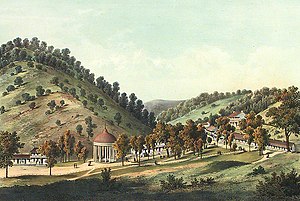
Monroe County is a county in the U.S. state of West Virginia. As of the 2020 census, the population was 12,376. Its county seat is Union. Monroe County was the home of Andrew Summers Rowan of Spanish–American War fame, who is immortalized in Elbert Hubbard's classic A Message to Garcia. The county was also the site of the 1928 discovery of the 34.48 carat Jones Diamond by Grover C. Jones and William "Punch" Jones. Monroe County celebrates its own holiday, Farmers' Day.

Greenbrier County is a county in the U.S. state of West Virginia. As of the 2020 census, the population was 32,977. Its county seat is Lewisburg. The county was formed in 1778 from Botetourt and Montgomery counties in Virginia.

White Sulphur Springs is a city in Greenbrier County in southeastern West Virginia, United States. The population was 2,231 at the 2020 census. The city emblem consists of five dandelion flowers and the citizens celebrate spring with an annual Dandelion Festival.

Addison, commonly known as Webster Springs, is a town in and the county seat of Webster County, West Virginia, United States. Although it was incorporated as Addison in 1892, it is more frequently referred to as Webster Springs, the name of the town's post office. It was named for Addison McLaughlin, upon whose land the town was originally laid out. The population was 731 at the 2020 census.

The Greenbrier is a luxury resort located in the Allegheny Mountains near White Sulphur Springs in Greenbrier County, West Virginia, in the United States.
Minnehaha Springs is an unincorporated community located in Pocahontas County, West Virginia, United States. It was named for the fictional Native American "princess," Minnehaha, and the mineral springs on the Lockridge farm. It is the only community with this name in the United States. On the site of what is now Camp Twin Creeks warm mineral springs can still be found.

The Omni Homestead Resort is a luxury resort in Hot Springs, Virginia, United States, in the middle of the Allegheny Mountains. The area has the largest hot springs in the commonwealth, and the resort is also known for its championship golf courses, which have hosted several national tournaments. The resort also includes an alpine ski resort; founded in 1959, it is the oldest in Virginia. The resort has been designated a National Historic Landmark; it has a history extending more than two and a half centuries. The Omni Homestead Resort is a member of Historic Hotels of America the official program of the National Trust for Historic Preservation.

Henry Mason Mathews was an American military officer, lawyer, and politician in the U.S. State of West Virginia. Mathews served as 7th Attorney General of West Virginia (1873–1877) and 5th Governor of West Virginia (1877–1881), being the first former Confederate elected to the governorship in the state. Born into a Virginia political family, Mathews attended the University of Virginia and afterward practiced law before the outbreak of the American Civil War. When Virginia seceded from the United States, in 1861, he volunteered for the Confederate States Army and served in the western theater as a major of artillery. Following the war, Mathews was elected to the West Virginia Senate, but was denied the seat due to state restrictions on former Confederates. Mathews participated in the 1872 state constitutional convention that overturned these restrictions, and in that same year was elected attorney general of West Virginia. After one term, he was elected governor of West Virginia.

White Sulphur Springs station is a railway station in White Sulphur Springs, West Virginia, served by Amtrak, the national passenger railway. The station is a stop on Amtrak's Cardinal route.

The Red Sulphur Springs Hotel was a spring resort in Red Sulphur Springs, West Virginia. It held a social event every evening. When residents died there, to avoid compromising its reputation, bodies were secretly taken to a cemetery about two miles away, where many of the grave markers have no name. The hotel opened in 1832 and closed in 1917; the last event held there was a dance. At one time Martin Van Buren, the president of the United States, visited the hotel, which was once owned by Levi Morton, Vice President under Benjamin Harrison. After its closure in 1917, the hotel was dismantled and only a small, concrete base remains where the pavilion once stood.

Pence Springs is an unincorporated community in Summers County, West Virginia, United States. It lies along the Greenbrier River to the east of the city of Hinton, the county seat of Summers County. Its elevation is 1,539 feet, and it is located at 37°40′41″N80°43′30″W. It had a post office with the ZIP code 24962 until it was closed in October 2011.

Salt Sulphur Springs is an unincorporated community in Monroe County, West Virginia, United States. Salt Sulphur Springs is located on U.S. Route 219, southwest of Union.
Blue Sulphur Springs is an unincorporated community in Greenbrier County, West Virginia, United States. Blue Sulphur Springs is north of Alderson. It is named for a mineral spring near the original town site, distinguishing it from the larger and better-known White Sulphur Springs in the same county. It was the site of the Blue Sulphur Springs Resort, of which only the pavilion remains.

Salt Sulphur Springs Historic District is a national historic district located at Salt Sulphur Springs, near Union, West Virginia, Monroe County, West Virginia. The district includes seven contributing buildings, three contributing sites, and two contributing structures related to the Old Salt Sulphur Springs Resort or "Old Salt." Notable properties include the Old Stone Hotel, Episcopal Chapel, Stone Store Building (1820), Stone Bath House (1820), Stone Spring House, Sweet Sulphur Springs Site, Salt Sulphur Spring, and Iodine Spring (1838). It is the area's most significant collection of native limestone buildings.

The western part of Virginia which became West Virginia was settled in two directions, north to south from Pennsylvania, Maryland and New Jersey and from east to west from eastern Virginia and North Carolina. The earliest arrival of enslaved people was in the counties of the Shenandoah Valley, where prominent Virginia families built houses and plantations. The earliest recorded slave presence was about 1748 in Hampshire County on the estate of Thomas Fairfax, 6th Lord Fairfax of Cameron, which included 150 enslaved people. By the early 19th century, slavery had spread to the Ohio River up to the northern panhandle.

Sweet Springs Resort and spa was founded in Sweet Springs, West Virginia, United States in 1792. Once known as Old Sweet Springs, this historic resort hotel is currently undergoing renovation by the nonprofit Sweet Springs Resort Park Foundation. The property enjoys notoriety for its natural hot spring.

The Blue Sulphur Springs Pavilion is a historic Greek Revival structure in Blue Sulphur Springs, West Virginia, United States. The Pavilion is the only surviving structure from the Blue Sulphur Springs Resort, a 19th-century mineral spa, and was built to shelter the sulphur spring at the resort. The Pavilion consists of twelve columns holding up a square roof, and is primarily built with brick. It was built in 1834 along with the resort and was added to the National Register of Historic Places on October 29, 1992.
Kate's Mountain, south of White Sulphur Springs in Greenbrier County, West Virginia, was named for Catherine "Kate" Carpenter, who in September 1756 took refuge with her child on the mountain's peak during an Indian attack in which her husband Nicholas Carpenter was killed near Fort Dinwiddie in the vicinity of White Sulphur Springs, West Virginia. Kate's Mountain is the highest of the peaks in Greenbrier State Forest at 3,280 feet. Kate's Mountain was the inspiration for the 19th Century romantic poem The Mystic Circle of Kate's Mountain, first published in fragmentary form in 1860 and published in its entirety in 1895. Kate's Mountain is the type location for Kate's Mountain clover, Trifolium virginicum, the symbol of the West Virginia Native Plant Society.
Catherine "Kate" Carpenter, born probably ca. 1730s, died 1784, was a frontier wife and mother for whom Kate's Mountain in Greenbrier County, West Virginia is named.

Edward Beyer (1820–1865) was a German landscape painter who was active in the United States and became known for his depiction of the Antebellum South.



















